
A suspension bridge is a type of bridge in which the deck is hung below suspension cables on vertical suspenders. The first modern examples of this type of bridge were built in the early 1800s. Simple suspension bridges, which lack vertical suspenders, have a long history in many mountainous parts of the world.

An arch bridge is a bridge with abutments at each end shaped as a curved arch. Arch bridges work by transferring the weight of the bridge and its loads partially into a horizontal thrust restrained by the abutments at either side. A viaduct may be made from a series of arches, although other more economical structures are typically used today.

The General Rafael Urdaneta Bridge is located at the Tablazo Strait outlet of Lake Maracaibo, in western Venezuela. The bridge connects Maracaibo with much of the rest of the country. It is named after General Rafael Urdaneta, a Venezuelan hero of Independence who was born in Maracaibo.

The 25 de Abril Bridge is a suspension bridge connecting the city of Lisbon, capital of Portugal, to the municipality of Almada on the left (south) bank of the Tagus River. It has a main span length of 1,013 metres (3,323 ft), making it the 48th longest suspension bridge in the world.
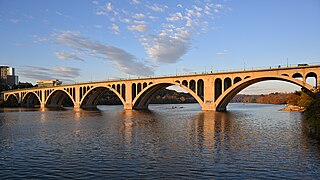
The Francis Scott Key Bridge, more commonly known as the Key Bridge, is a six-lane reinforced concrete arch bridge carrying U.S. Route 29 (US 29) across the Potomac River between the Rosslyn neighborhood of Arlington County, Virginia, and the Georgetown neighborhood of Washington, D.C. Completed in 1923, it is Washington's oldest surviving road bridge across the Potomac River.

The Arrábida Bridge is an arch bridge of reinforced concrete which carries six lanes of traffic over the Douro River, between Porto and Vila Nova de Gaia, in the Norte region of Portugal.
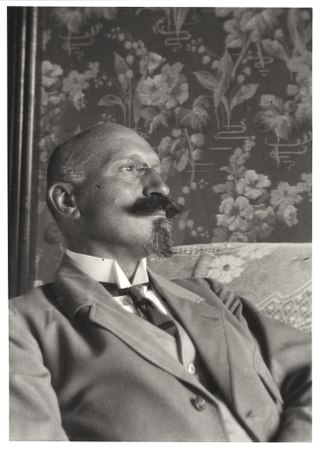
Robert Maillart was a Swiss civil engineer who revolutionized the use of structural reinforced concrete with such designs as the three-hinged arch and the deck-stiffened arch for bridges, and the beamless floor slab and mushroom ceiling for industrial buildings. His Salginatobel (1929–1930) and Schwandbach (1933) bridges changed the aesthetics and engineering of bridge construction dramatically and influenced decades of architects and engineers after him. In 1991 the Salginatobel Bridge was declared an International Historic Civil Engineering Landmark by the American Society of Civil Engineers.

Bagni di Lucca is a comune of Tuscany, Italy, in the Province of Lucca with a population of about 6,100. The comune has 27 named frazioni (wards).

The Magra is a 62-kilometre (39 mi) long river of Northern Italy, which runs through Pontremoli, Filattiera, Villafranca in Lunigiana and Aulla in the province of Massa-Carrara (Tuscany); Santo Stefano di Magra, Vezzano Ligure, Arcola, Sarzana and Ameglia in the province of La Spezia (Liguria).

Borgo a Mozzano is a town and comune in the province of Lucca, in northern Tuscany (Italy), located on the Serchio River.

Aulla is a comune in the province of Massa and Carrara, Tuscany, central Italy. It is located in the valley of the River Magra.
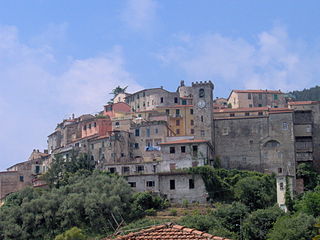
Ameglia is a comune (municipality) in the Province of La Spezia in the Italian region of Liguria, located about 90 kilometres (56 mi) southeast of Genoa and about 11 kilometres (7 mi) southeast of La Spezia.

The Nowra Bridge is a road bridge that carries the Princes Highway over the Shoalhaven River, at Nowra, New South Wales, Australia. The bridge joins the main area of Nowra to North Nowra and Bomaderry.

Riccardo Morandi was an Italian civil engineer best known for his innovative use of reinforced concrete and prestressed concrete, although over the years some of his particular cable-stayed bridges have had some maintenance trouble.
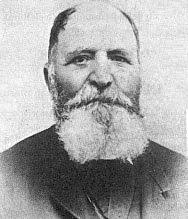
Joseph Monier was a French gardener and one of the principal inventors of reinforced concrete.
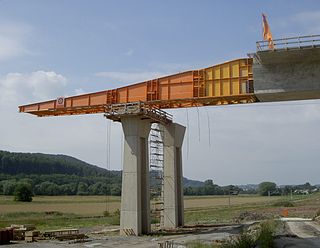
Incremental launch is a method in civil engineering of building a complete bridge deck from one abutment of the bridge only, manufacturing the superstructure of the bridge by sections to the other side. In current applications, the method is highly mechanised and uses pre-stressed concrete.
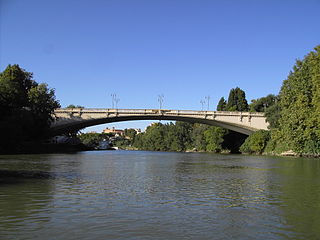
Ponte del Risorgimento is a bridge that links Piazzale delle Belle Arti to Piazza Monte Grappa in Rome (Italy), in the Flaminio and Della Vittoria quarters.

Ponte Morandi, officially Viadotto Polcevera, was a road viaduct in Genoa, Liguria, Italy, constructed between 1963 and 1967 along the A10 motorway over the Polcevera River, from which it derived its official name. It connected Genoa's Sampierdarena and Cornigliano districts across the Polcevera Valley. The bridge was widely called "Ponte Morandi" after its structural designer, engineer Riccardo Morandi.

The Genoa Saint George Bridge is a motorway viaduct that crosses the Polcevera river and the districts of Sampierdarena and Cornigliano, in the city of Genoa. It was designed by architect Renzo Piano.
Attilio Giacomo Muggia was an Italian engineer and architect.




















